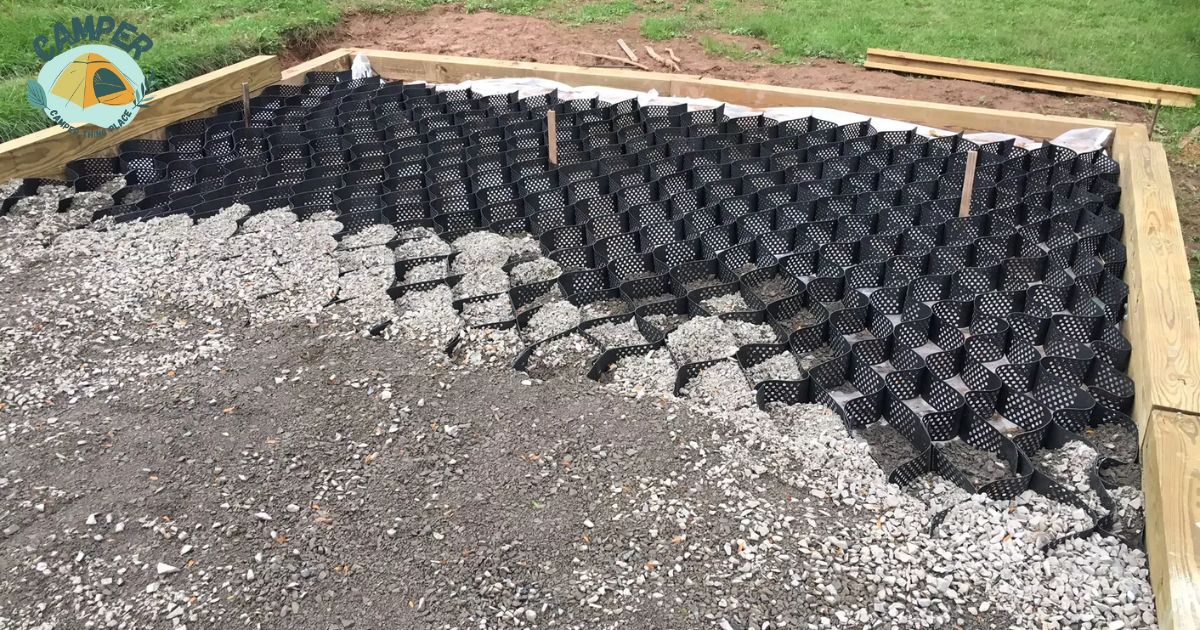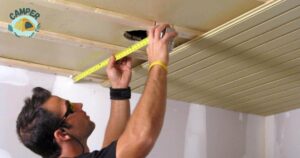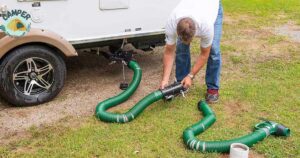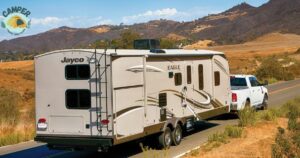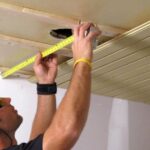An RV pad is a designated space designed for parking recreational vehicles, often equipped with facilities like electrical hookups. Found in campgrounds, it provides a convenient and comfortable spot for RV enthusiasts to park and enjoy their travels.
Building an RV pad involves several factors that determine its cost. So some people want to know how much it costs to build an RV pad. It depends on Location and prices vary based on the region. The size of the pad is crucial; larger spaces cost more. Materials used for construction influence expenses. Electric and water connections add to the overall price. Consider these factors when planning to build an RV pad.
Building an RV pad can vary in cost. Factors like size, location, and amenities influence the price. On average, basic setups might start around $1,000, but Constructing an RV pad with concrete typically increases the overall cost. Concrete pads offer durability and stability, but they come at a higher price. Basic concrete pads might start around $2,000, while larger or more intricate designs can push the cost higher. Keep in mind that factors like site preparation, concrete quality, and labor influence the final expense.
Why is Concrete So Much More Expensive?
Concrete is often more expensive due to several factors. First, the materials themselves, including cement, aggregates, and additives, contribute to the overall cost. Additionally, the process of mixing, pouring, and finishing concrete requires skilled labor, which adds to the expenses.
Site preparation for a concrete pad may also involve more intricate work, further increasing costs. The durability and longevity of concrete contribute to its higher upfront price, as it offers a solid and long-lasting foundation for structures like an RV pad.
The Size of Your Pad Matters
Choosing the right size for your RV pad is crucial. A spacious pad provides room for maneuvering and comfort.
One smart option is using permeable pavers. These special pavers allow water to pass through, reducing runoff and preventing puddles. The benefits extend to your RV’s tires, as permeable pavers offer a stable surface. Now, let’s talk price.
While permeable pavers may have a slightly higher initial cost. You could be looking at a cost of around $187 per 72 square feet camper, totaling slightly over $900 for a lot measuring 16 by 22 sq ft
The long-term advantages, including better drainage and durability, make them a wise investment for your RV pad. Consider the size wisely; it matters for both convenience and functionality.
The size of your RV pad significantly influences the overall cost. A larger pad requires more materials, such as gravel or concrete, and increased labor for installation
What Are Permeable Pavers?
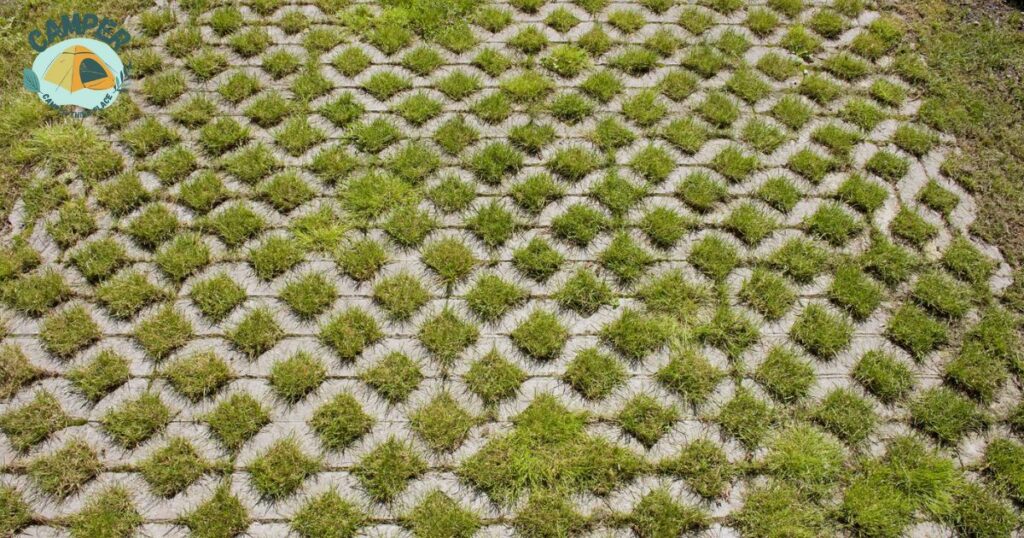
Permeable pavers are a smart choice. These pavers have special designs that allow water to pass through them. This feature helps prevent water runoff and reduces puddles on your RV pad.
The permeable nature of these pavers offers better water drainage, which is beneficial for both the RV and the surrounding area. Plus, they provide a stable surface for your RV’s tires. It’s a practical solution for a cleaner, more efficient RV pad.
What Do Permeable Pavers Cost?
The price of permeable Pavers depends on many factors. On average, permeable pavers can range from $4 to $6 per sq ft Keep in mind that this cost may vary based on the type and brand of pavers you choose.
Now, let’s talk about labor charges. Installing permeable pavers involves both material and labor costs. Labor charges can range from $10 to $25 per square feet, depending on factors like site preparation and complexity.
While the initial investment might be a bit higher, the long-term benefits of improved drainage and durability make permeable pavers a wise choice for your RV pad.
Permeable Pavement Cleaning Cost
Cleaning permeable pavement comes with reasonable costs. On average, professional cleaning services for permeable pavement range from $0.10 to $0.25 per sq ft
The exact cost can vary based on factors such as the extent of cleaning needed, the type of permeable pavement, local service rates, and specific features like RV hookups. Regular maintenance helps ensure the continued effectiveness of permeable pavement, preventing clogs and maintaining optimal water drainage.
While the cleaning cost is a factor, the long-term benefits of a well-maintained permeable pavement, including enhanced sustainability and longevity, make it a worthwhile investment.
Advantages of Permeable Paving Systems
Permeable paving systems offer a host of advantages. Making them a popular and eco-friendly choice for various applications. Here we mentioned some advantages about it.
- Permeable paving allows water to pass through, minimizing runoff and reducing the risk of puddles.
- Replenishes groundwater, contributes to water conservation, and reduces strain on stormwater management systems.
- Suitable for high-traffic areas, with materials designed to withstand heavy loads and resist wear and tear.
- Absorbs less heat, helping to keep urban areas cooler.
- Allows for natural filtration, reducing the risk of contaminants reaching groundwater.
- Customizable options with various colors, shapes, and materials for visually appealing designs.
- While the initial installation cost may be slightly higher, permeable paving often results in reduced maintenance expenses over time.
- Offers a balance between functionality, durability, and environmental impact.
Different Types Of Permeable Pavers
When it comes to RV pads, choosing the right permeable pavers is crucial. Permeable pavers allow water to drain through, preventing puddles and enhancing the overall durability.
There are various types to consider:
Grass Pavers: These eco-friendly pavers have open grids, allowing grass to grow through, blending aesthetics with functionality.
Gravel Pavers: Perfect for a rustic look, these pavers have interconnected cells filled with gravel, providing excellent drainage.
Interlocking Concrete Pavers: Sturdy and versatile, these pavers come in various designs, ensuring a stable surface while allowing water to seep through the gaps.
Porous Asphalt Pavers: Combining the strength of asphalt with permeability, these pavers are a durable choice for RV pads.
Choosing the right type depends on your preferences and needs. Whether you favor a green appearance or a classic gravel look, permeable pavers offer a solution for a practical and visually appealing RV pad.
How to Build a Pad With Permeable Pavers
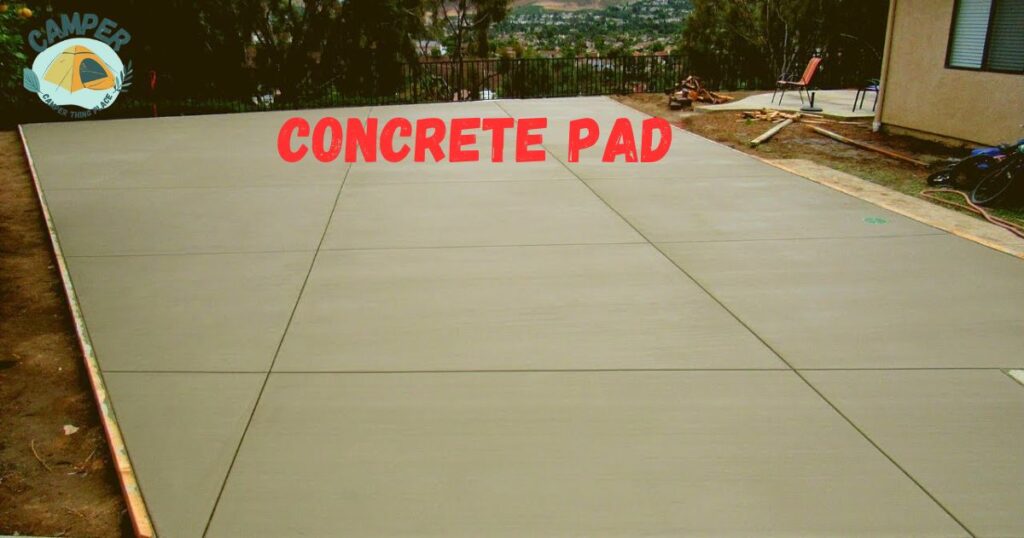
Building a pad with permeable pavers is simple. Start by choosing a location for your pad. Measure the area and mark it clearly. Dig about six inches into the ground for a solid base.
Next, add gravel to the dug-out area. Level it carefully for stability. Compact the gravel using a tamper. This creates a strong foundation for your permeable pavers.
Now, it’s time to lay the permeable pavers. Arrange them according to your preferred pattern. Make sure they fit snugly together.
Fill the gaps between the pavers with fine gravel. This allows water to seep through easily. Compact the pavers one more time for durability.
Lastly, give your new pad a good soak. This helps settle the pavers in place
How to Build a Pad With Gravel or Concrete?
Building a pad with gravel or concrete is simple. It includes some steps. Follow these steps for building a pad with gravel or concrete
Mark the Area
Before you start building a pad with gravel or concrete, mark the designated area clearly. Use stakes and string to outline the perimeter of the pad.
This step helps you visualize the space and ensures accuracy in excavation or gravel spreading. Double-check the measurements and make adjustments if needed.
Dig Out the Ground and Level It
Once you’ve marked the designated area for your pad, the next step is to dig out the ground. Using a shovel or a bulldozer, remove the topsoil and any debris to reach the desired depth for your foundation.
Ensure that the excavated area follows the marked perimeter. After excavation, take a moment to level the ground. Use a level tool to make sure the surface is even and flat.
This step is crucial for both gravel and concrete pads, providing a stable base for your construction project. A well-leveled surface contributes to the overall strength and durability of the foundation.
Arrange the Gravel
Now that the ground is prepped, the next step in building an RV pad is arranging the gravel. Spread a layer evenly over the excavated area, opting for a mix of gravel sizes for better compaction.
Use a rake for an even distribution, focusing on the edges. Compact the gravel firmly with a tamper to create a stable foundation. This step ensures proper drainage and longevity for your RV pad.
Pour the Cement
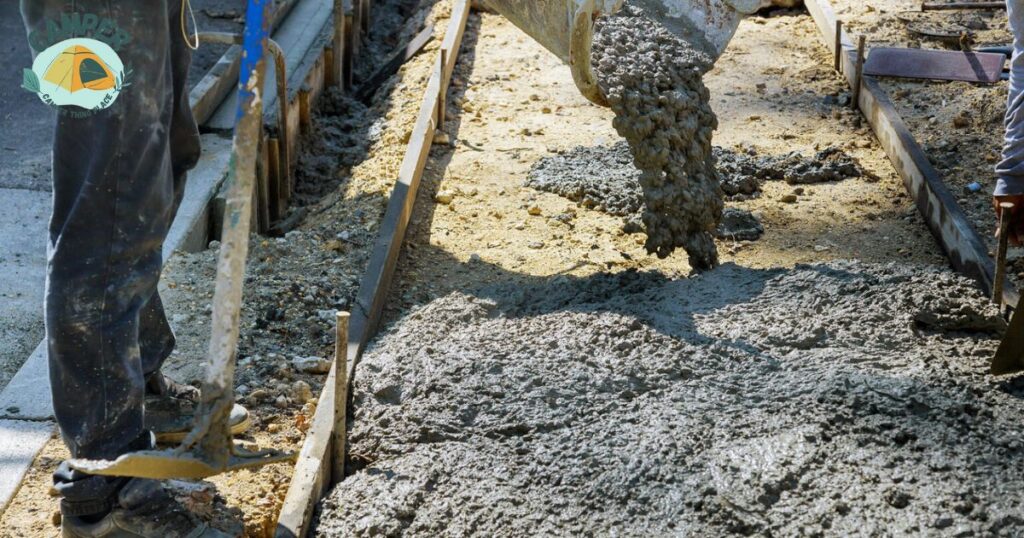
If you’ve chosen to build your RV pad with concrete, the next step is pouring the cement. Once the ground is excavated and leveled, set up formwork to define the pad’s shape.
Mix the concrete according to the manufacturer’s instructions and pour it evenly into the formwork.
Use a trowel to smooth the surface and eliminate any air pockets. Allow the concrete to cure thoroughly, following recommended drying times.
This step ensures a solid and durable foundation for your RV, providing stability and longevity to your outdoor space.
Do You Need a Permit to Build A Pad With Gravel?
Whether you need a permit to build a pad with gravel depends on your local regulations. Check with your local building department or city planning office to understand the specific requirements in your area.
In some places, constructing a gravel pad may not require a permit, especially for smaller projects. However, larger or more complex projects might need approval. It’s crucial to clarify this before starting to ensure compliance with local codes and regulations.
Always consult with the appropriate authorities to avoid any legal issues and to guarantee that your project aligns with the necessary standards. This proactive approach can save you time and potential complications down the line.
Get an Expert Opinion
Consulting with a local contractor or city building department is crucial to determine whether a permit is needed for your gravel pad project. These experts can provide specific insights into local regulations, ensuring compliance and a smooth construction process.
Taking the time to seek expert opinions early in the planning stages can save you potential headaches later on and contribute to the successful completion of your project.
Can You Build an RV Park?
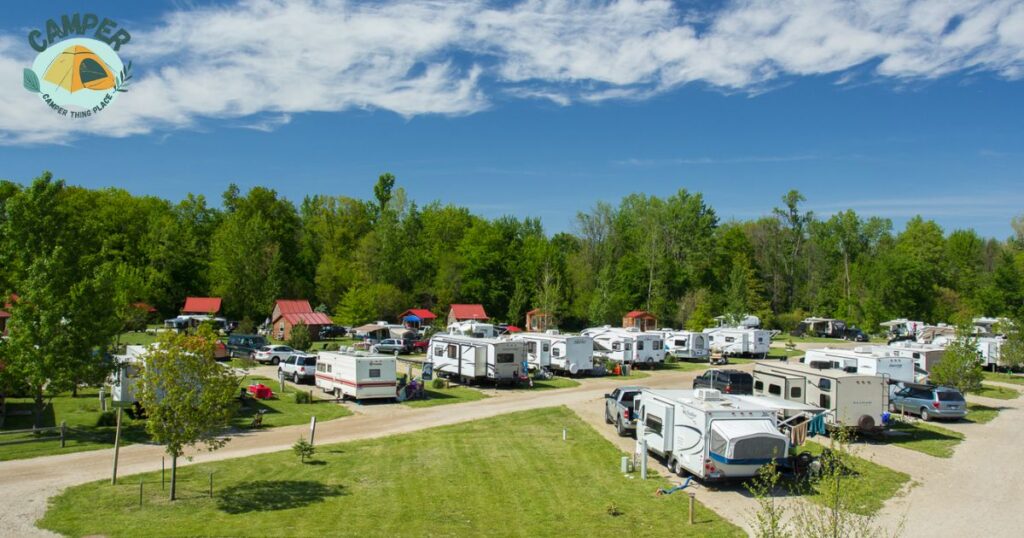
Yes, you can definitely build your own RV park, but it’s a significant investment. Keep in mind that you’re essentially starting a business, so take some time to think it through. The cost to build an RV park can be around $80,000 or more.
To break it down, you’ll need to purchase land, and in the United States, it can be roughly $3,000 per acre. Building around 10 RV pads might cost you $40,000. Additionally, factor in expenses like electricity (around $2,500), water (approximately $5,000 if you need to dig a well), and a septic tank, which could run you $30,000.
All in all, you could end up spending $80,000, and even with that investment, your RV park may be more standard than impressive.
Remember, the costs can vary based on your location, and you might end up paying more than the average per acre. Consider all these factors before diving into the RV park venture.
How Much Can You Earn from an RV Park?
Building a successful RV park can be a lucrative venture, with the potential for substantial earnings. Successful investments often yield significant returns, and an average RV park owner can make around $90,000 annually. So, if your investment pans out, the payoff could be quite substantial.
The income generated from your park can be reinvested to enhance the facilities. For instance, you might consider investing in amenities like a fantastic swimming pool, which could cost around $75,000. This way, you can continually improve and expand your RV park, making it an even more attractive destination for visitors.
Can You Put a Lot of RV Pads on Your Lot?
You have the flexibility to add numerous RV pads to your lot, depending on its size and local regulations. If your lot is spacious and complies with zoning laws, you can strategically design and layout multiple RV pads.
Keep in mind that proper spacing, accessibility, and amenities are crucial to creating a welcoming environment for RV fans.
Before proceeding, it’s essential to check local regulations and zoning requirements to ensure compliance. Factors such as safety, utility connections, and waste disposal should be considered while planning the placement of RV pads.
With thoughtful design and adherence to regulations, you can maximize the potential of your lot, accommodating a significant number of RV pads to create a thriving and attractive RV park.
Frequently Asked Question
Can You Live in Your RV on a Lot You Own?
Yes, you can live in your RV on a lot you own, but local zoning regulations and ordinances may dictate the length of stay and specific requirements.
How much space is needed for an RV pad?
The space needed for an RV pad varies, but a standard recommendation is around 12 feet in width and at least 20-25 feet in length to accommodate most RVs.
How thick should an RV pad be?
An RV pad typically requires a thickness of 4 to 6 inches of concrete for adequate support and durability.
How Much Does A Concrete RV Pad Cost?
The cost of a concrete RV pad ranges from $6 to $12 per sq ft, depending on location and specific project factors.
Final Thoughts
The cost of building an RV pad depends on various factors. Location, materials, and size play crucial roles in determining the overall expenses. It’s essential to plan carefully, considering your specific needs and budget constraints. To sum up, while costs may vary, investing time in research and consulting with professionals can help you create a realistic budget for your RV pad project. So here we solve this question how much does it cost to build an RV pad? By understanding the key factors influencing the expenses, you can embark on this endeavor confidently, ensuring a smoot

Jackson Ray, a seasoned blogger with a decade of experience, is the creative mind behind “camperthingsplace.com.” Explore his wealth of insights and passion for camping through engaging content on the website.
